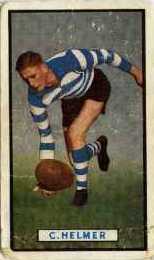By Lynda Carroll
The world spins; at the moment it seems to spin out of control. On Sunday, it spun at an angle as Adam Tomlinson took a late kick – potentially a game winner for Melbourne – and missed.
It was three points to Geelong. The empty MCG gathered another game into its collection, the Cats’ theme song rang out, and we sighed red and blue disappointment into the ether. Episodes of goodness aside – three of the game’s last four goals, a one-point lead at half time – this was not a glorious game by any measurement. With fourteen scoring shots to twelve, the Demons undoubtedly had their chances, but couldn’t make the most of them.
How we would have loved to hear the ‘Grand Old Flag’, but a subsiding third quarter put paid to that. Four goals to one meant that it was always going to be a losing battle and a scrappy game, albeit one fought valiantly around the ground.
The most recent win for Melbourne against Geelong at the MCG was a stark contrast to the weekend just gone. It was the Elimination Final of 2018, attended by nearly 92,000, won by Melbourne with (unexpected) relative ease. Holding Geelong goalless in the first quarter set the tone for an overflow of home side happiness. Youngster Sam Weideman featured with three goals, Gawn highlighted his All Australian credentials with 42 hitouts, and a comfortable four to five goal margin was maintained until the final siren sounded, signalling an outpouring of celebration from finals starved Melbourne supporters.
Meetings between these senior members of the competition are peppered with such cameos, and a bond that goes back to the pioneering days of the late 1850s and early 1860s. It has survived through three centuries and two world wars, with the latter marking perhaps the most poignant name shared between the two. This, without doubt, is Clyde Helmer. Hailing from Mooroopna, he played his first game with Geelong in 1937, and was noticed by Melbourne legend Ivor Warne-Smith, writing in The Argus in June 1937:
Before the Geelong-Melbourne game last Saturday people were interested in Clyde Helmer, Geelong’s centre half-forward. As the teams ran out on to the ground many curious eyes followed Helmer. The first opinion was not generous, for he did not look the perfect physical athlete….Helmer is a better player than the average at evading ticklish situations. He apparently has the quality of thinking out brighter moves than his opponents, which puts him in a class above others. He is not a champion yet, but if his wiry frame can withstand buffeting he will improve.
A bomb disposal specialist, Helmer had just turned 29 when he was killed while disarming a bomb on 24 April 1945. The waves of sorrow were immediate throughout the football community for Warrant Officer Reginald Clyde ‘Snowy’ Helmer, newly married to Marjorie. From South Sydney to Mooroopna, footballers stood in silent tribute to Helmer and others lost in conflict. Helmer was also embraced by both Geelong and Melbourne, with the Demons listing him as one of those ‘who will never return, but Melbourne members will long cherish their memory.’
The game, of course, is made up of memories. As we remember the likes of Helmer from 75 years ago, so we will remember the spin of the ball, the echo of players’ voices in an empty stadium, and the predictable unpredictability of seasons and lives, from distant wartime to the tumult of 2020.
MELBOURNE 0.1 - 2.3 - 3.5 - 6.8 (44)
GEELONG 2.1 - 2.2 - 6.4 - 7.5 (47)
GOALS
Melbourne: Brayshaw 2, Fritsch, Petracca, Hunt, McDonald
Geelong: Hawkins, Fort, Duncan, Ratugolea, Dangerfield, Parfitt, Guthrie
BEST
Melbourne: Oliver, Viney, Petracca, Gawn, Brayshaw, Tomlinson,
Geelong: Guthrie, Menegola, Dangerfield, Selwood, Parfitt, Duncan
INJURIES
Melbourne: Nil
Geelong: Tom Stewart (collarbone)
The world spins; at the moment it seems to spin out of control. On Sunday, it spun at an angle as Adam Tomlinson took a late kick – potentially a game winner for Melbourne – and missed.
It was three points to Geelong. The empty MCG gathered another game into its collection, the Cats’ theme song rang out, and we sighed red and blue disappointment into the ether. Episodes of goodness aside – three of the game’s last four goals, a one-point lead at half time – this was not a glorious game by any measurement. With fourteen scoring shots to twelve, the Demons undoubtedly had their chances, but couldn’t make the most of them.
How we would have loved to hear the ‘Grand Old Flag’, but a subsiding third quarter put paid to that. Four goals to one meant that it was always going to be a losing battle and a scrappy game, albeit one fought valiantly around the ground.
The most recent win for Melbourne against Geelong at the MCG was a stark contrast to the weekend just gone. It was the Elimination Final of 2018, attended by nearly 92,000, won by Melbourne with (unexpected) relative ease. Holding Geelong goalless in the first quarter set the tone for an overflow of home side happiness. Youngster Sam Weideman featured with three goals, Gawn highlighted his All Australian credentials with 42 hitouts, and a comfortable four to five goal margin was maintained until the final siren sounded, signalling an outpouring of celebration from finals starved Melbourne supporters.
Meetings between these senior members of the competition are peppered with such cameos, and a bond that goes back to the pioneering days of the late 1850s and early 1860s. It has survived through three centuries and two world wars, with the latter marking perhaps the most poignant name shared between the two. This, without doubt, is Clyde Helmer. Hailing from Mooroopna, he played his first game with Geelong in 1937, and was noticed by Melbourne legend Ivor Warne-Smith, writing in The Argus in June 1937:
Before the Geelong-Melbourne game last Saturday people were interested in Clyde Helmer, Geelong’s centre half-forward. As the teams ran out on to the ground many curious eyes followed Helmer. The first opinion was not generous, for he did not look the perfect physical athlete….Helmer is a better player than the average at evading ticklish situations. He apparently has the quality of thinking out brighter moves than his opponents, which puts him in a class above others. He is not a champion yet, but if his wiry frame can withstand buffeting he will improve.

A bomb disposal specialist, Helmer had just turned 29 when he was killed while disarming a bomb on 24 April 1945. The waves of sorrow were immediate throughout the football community for Warrant Officer Reginald Clyde ‘Snowy’ Helmer, newly married to Marjorie. From South Sydney to Mooroopna, footballers stood in silent tribute to Helmer and others lost in conflict. Helmer was also embraced by both Geelong and Melbourne, with the Demons listing him as one of those ‘who will never return, but Melbourne members will long cherish their memory.’
The game, of course, is made up of memories. As we remember the likes of Helmer from 75 years ago, so we will remember the spin of the ball, the echo of players’ voices in an empty stadium, and the predictable unpredictability of seasons and lives, from distant wartime to the tumult of 2020.
MELBOURNE 0.1 - 2.3 - 3.5 - 6.8 (44)
GEELONG 2.1 - 2.2 - 6.4 - 7.5 (47)
GOALS
Melbourne: Brayshaw 2, Fritsch, Petracca, Hunt, McDonald
Geelong: Hawkins, Fort, Duncan, Ratugolea, Dangerfield, Parfitt, Guthrie
BEST
Melbourne: Oliver, Viney, Petracca, Gawn, Brayshaw, Tomlinson,
Geelong: Guthrie, Menegola, Dangerfield, Selwood, Parfitt, Duncan
INJURIES
Melbourne: Nil
Geelong: Tom Stewart (collarbone)

